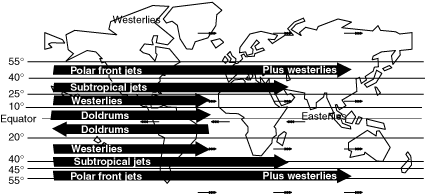planetary winds — Wind patterns that prevail over large regions, planetary in size and on the average fairly constant in direction. Also called terrestrial winds. Planetary winds … Aviation dictionary
climate — /kluy mit/, n. 1. the composite or generally prevailing weather conditions of a region, as temperature, air pressure, humidity, precipitation, sunshine, cloudiness, and winds, throughout the year, averaged over a series of years. 2. a region or… … Universalium
Earth Sciences — ▪ 2009 Introduction Geology and Geochemistry The theme of the 33rd International Geological Congress, which was held in Norway in August 2008, was “Earth System Science: Foundation for Sustainable Development.” It was attended by nearly… … Universalium
global warming — an increase in the earth s average atmospheric temperature that causes corresponding changes in climate and that may result from the greenhouse effect. [1975 80] * * * Potential increase in global average surface temperatures resulting from… … Universalium
Venus — This article is about the planet. For other uses, see Venus (disambiguation). Venus … Wikipedia
Antarctica — /ant ahrk ti keuh, ahr ti /, n. the continent surrounding the South Pole: almost entirely covered by an ice sheet. ab. 5,000,000 sq. mi. (12,950,000 sq. km). Also called Antarctic Continent. * * * Antarctica Introduction Antarctica Background:… … Universalium
Atmosphere of Jupiter — Cloud pattern on Jupiter in 2000 The atmosphere of Jupiter is the largest planetary atmosphere in the Solar System. It is mostly made of molecular hydrogen and helium in roughly solar proportions; other chemical compounds are present only in… … Wikipedia
Mars — /mahrz/, n. 1. the ancient Roman god of war and agriculture, identified with the Greek god Ares. 2. Astron. the planet fourth in order from the sun, having a diameter of 4222 miles (6794 km), a mean distance from the sun of 141.6 million miles… … Universalium
Storm — Windstorm redirects here. For the type of storm in Europe, see European windstorm. For the Gloria Jones album, see Windstorm (album). For other uses, see Storm (disambiguation). A shelf cloud associated with a heavy or severe thunderstorm over… … Wikipedia
Thunderstorm — Electrical storm redirects here. For other uses, see Electrical storm (disambiguation). A typical thunderstorm A thunderstorm, also known as an electrical storm, a lightning storm, thundershower or simply a storm is a form of weather… … Wikipedia
 Terresterial winds in January.
Terresterial winds in January.